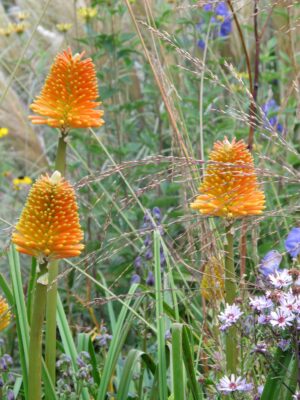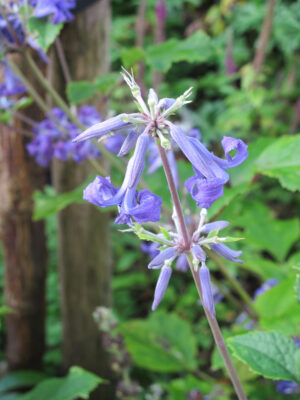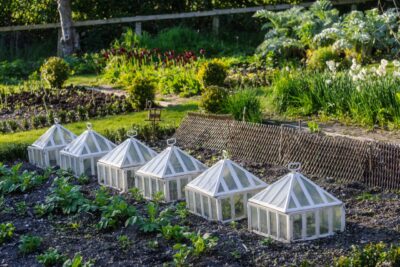I picked up a copy of The Times the other day to be met by a headline declaring that the wet weather we’ve been having is affecting our mental health. Yes, we are all feeling under the weather Mr Times, but we’ll all recover once the sun shines again. And so will my garden. It’s been weather-affected as never before and I’ve seen my snowdrops, crocuses and daffodils turn to soggy mush. My cherry blossom and daphne flowers have been blown off, laying like damp confetti but without the blushing bride. I’ve no need to build an ark, like Noah did, for I can retire to my Hartley greenhouse and dream of better times.
It’s been mild with temperatures in double figures, but we’ve also had a chilly wind in Cold Aston, so it’s never felt balmy despite what the BBC weathermen keep telling me. Lots of plants like the rain and when I visited South Africa, during their early austral summer, I couldn’t help noticing that most of the plants were close to streams and damp places. Agapanthus and kniphofias thrived in damp ditches or close to streams, because the summers were drier and hotter.

I was lucky enough to visit The Cape and the weather was surprisingly brisk in early October, their late spring, with a strong southerly blowing up from the South Pole. I had imagined a sunny paradise, but the two weeks I spent there were like Scotland in May if you take my meaning. My wardrobe wasn’t prepared either, for it wasn’t shorts weather. I wore the fleece and jeans I’d kept for the journey home instead. The Scottish vibe didn’t end there, for the rugged terrain of interlocking spurs, hills and valleys was very reminiscent of the Highlands. The vegetation, the fynbos, was mainly ericaceous too. I almost expected to see a red deer stag and a ghillie to appear.
Lots of plants with a South African provenance have proved highly useful in British gardens, because their pigment-packed flowers are able to shrug off rain and wind, as I can testify after my South African trip. They are not plants for dry gardens, because they experience a lot of rain in one season and that rain prompts them into flower. I almost scream when crocosmias, kniphofias and agapanthus are listed as suited to drought conditions. In 2021, a very dry summer, my crocosmias browned and shrivelled up. They came back in the following year.
The climate varies across The Cape. The western side gets the majority of its rainfall in austral winter, between June and August, followed by a hot, dry summer.The climate’s Mediterranean, with an average of 66 wet days and a yearly rainfall measuring 28 inches. The Eastern Cape gets an average of 128 rainy days annually and the wettest month is November and that month normally delivers a whacking 6 inches of rainfall. Despite that, the yearly average is only 22 inches and temperatures are moderate rather than hot and plants enjoy this. There’s a well-worn Garden Route a hundred miles east of Cape Town.
The temperature on both sides of The Cape stays above freezing, so the west conditions don’t compare to the UK. We get wet soil and freezing temperatures and some plants perish. We haven’t had much freezing weather in my garden this year, so I’m predicting a bumper year for my kniphofias and crocosmias following the mild, wet winter. Crocosmias have another trick up their sleeves. Some develop new corms above the old ones every year, so they push themselves deeper into the ground over time and this protects them from hard winters. When you dig them up, you might get six or seven corms in one string. Those with more rhizomatous roots, rather than corms, are more susceptible in cold, wet winters.

Crocosmia ‘Lucifer’ produces vertical strings of corms that go down deeply so you’ll be unlikely to lose it. However, there are drawbacks despite its excellent foliage. It flowers in early July, when the rest of the garden is full of pastels and roses and that makes it difficult to place. It’s also an aggressive grower on rich soil, with a tendency to march over its neighbours. ‘Lucifer’ is a toughie, but you need space for it.
I prefer later flowering crocosmias, because by then the floral palette is full of golden yellows, purples and blues. One my great favourites is ‘Star of the East’. You might imagine that this is connected to the Eastern Cape, but you’d be wrong. This crocosmia was raised in the East of England in 1910. It was named by George Davison, then Head Gardener at Westwick Hall in Norfolk. There were two more Norfolk-based crocosmia breeders in the early years of the 20th century, George Henley and Jack Fitt, and they raised a group known as. The Earlham hybrids.
The light East Anglian soil and low rainfall suited them, although this year East Anglia has had three times as much rainfall than usual. ‘Star of the East’ AGM is widely acknowledged as Davison’s finest, because the wide orange-brown flowers, reminiscent of barley sugar in colour, are so substantial and so late to appear. The size of flower is inherited from the pollen parent, a German variety called ‘Germania’.

‘Star of the East’ only grows in certain places and I have tried several and lost them. When it does well, it travels down a border, popping up a few feet away, and I’m not sure how it does it. It’s done well for me in a sheltered site close to the cottage, popping up through Clematis heracleifolia ‘Cassandra’, an herbaceous clematis with fragrant, deep-blue reflexed flowers.
‘Star of the East’ was thought lost from cultivation, but it was rediscovered by Graham Stuart Thomas, then the National Trust’s Garden Advisor. He spotted it at Hidcote Manor Garden in Gloucestershire and I’m not surprised. The gardening elite of the early 20th century, including Hidcote’s owner Lawrence Johnston, embraced these expensive, Norfolk-bred varieties in the Twenties and Thirties. E A Bowles, another famous gardener, painted many of them. Graham Stuart Thomas also rediscovered ‘Carmen Brilliant’ at Trelissick, ‘Lady Hamilton’ at Powis Castle and ‘Solfaterre’ at Trengwainton and Trelissick.
I grow another crocosmia named ‘Golden Ballerina’, which is a similar colour to ‘Star of the East’, but with narrow fly-away petals. It’s available from Hardy’s Cottage Garden Plants and Bressingham Gardens Plant Shop. This really suffered in the dry summer of 2023 as did another favourite named ‘Bright Eyes’. Both have grassy foliage. They light up the border in August and September.
Kniphofias are also from South Africa, but they are a step too far for most gardeners because they’re orange. Many lady gardeners veer away from it. “I can’t possibly have orange in the garden. It’s so common” the ladies who lunch often tell me. Well, I love it because it’s the touchpaper colour for blues and purples.
However, I am picky about my red hot pokers, because I remember the ubiquitous ‘Atlanta’ which grew in everyone’s garden in the 1950s and 1960s. It sent out yellow and orange flowers in June and the scruffy foliage was a dull grey-blue. It was invariably planted with equally coarse orange oriental poppies. ‘Atlanta’ was discovered in the garden of the long-gone Atlanta Hotel in Tintagel in Cornwall and it was named by Treseder’s Nursery based near Truro. It reminds me of another K. caulescens ‘John May’. I planted it. It revolted me, so I dug it up and put it in a wheelbarrow. It became one of Val’s wheelbarrow plants!

Kniphofias aren’t bombproof when it comes to hardiness. The ones with fine grassy foliage, such as ‘Penny Rockets’, disappear in hard winters. I’ve taken to cloching my favourites, like ‘Prince Igor’, ‘David Blake’ and K. rooperi because the roots can freeze in winter Cloching plants keeps them warmer and drier. If winters keep getting wetter, I’ll be cloching more of my plants! I have just discovered Claverton Cloches. A lovely addition to your garden.



